If you’re wondering how to keep your guppies happy and healthy, you’re in the right place.
In this article, I’m going to show 10 ways to keep your guppies happy and healthy.
Keep reading…

Table of Contents
1. Feed a varied high-quality diet to your guppies.
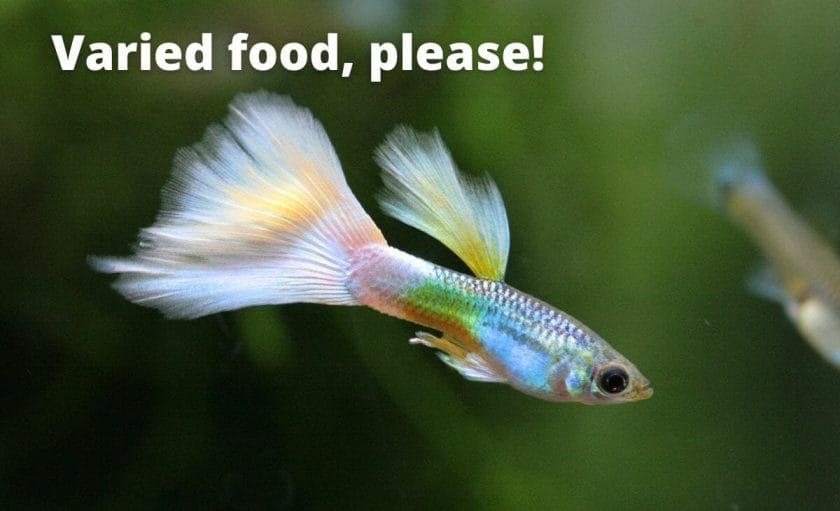
Guppies are omnivorous i.e. their diet is consists of both animal and plant-based foods.
So for their healthy growth, you should feed them high-quality foods.
Besides, you should not feed only one type of food to your guppies.
You should always try to mix things up to keep them happy.
You can feed frozen high-quality foods such as:
- Omega One Freshwater Flakes (Check reviews and price at Amazon here)
- Northfin Food Community Formula 0.5Mm Pellet (Check reviews and price at Amazon here)
- Cobalt Aquatics25142Ultra Guppy Nano Bits Floating (Check reviews and price at Amazon here)
- Omega One Color Mini Pellets, Sinking (Check reviews and price at Amazon here)
- Zoo Med Spirulina 20 Flake Fish Food (Check reviews and price at Amazon here)
You should also regularly feed them live food like Brine shrimp, Daphnia, and Bloodworms.
Besides, guppies can also eat plant-based foods. So you can also feed them vegetables periodically.
I have written an article on the different types of vegetables you can feed to your guppies. You can read the article here.
2. Choose the right tank size for guppies
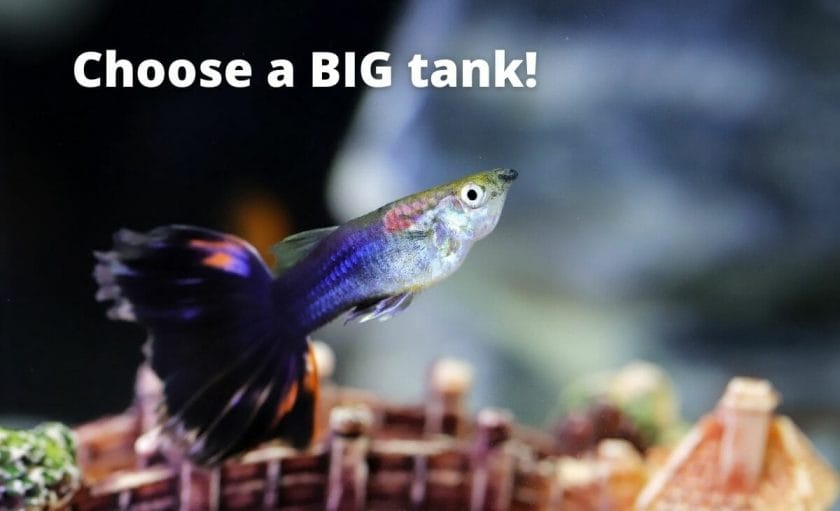
Choosing the right fish tank size is very important for keeping the guppies happy and healthy in your fish tank.
If you choose a very small fish tank then it will be a lot harder for you to maintain the ideal water quality.
A good rule of thumb to follow when it comes to tank size for guppies is 1 gallon per inch of guppy fish (3.7 liters for 2.5 cm of the guppy fish).
If you bought small guppies then you may think that you don’t need a larger tank but the reality is guppies can grow pretty fast.
So from the very beginning, you should choose a larger tank or the tank which could be sufficient for adult guppies.
Now the size of adult guppies varies from 1 to 2.5 inches (2.5 cm to 6.3 cm).
So generally, 2 gallons for 1 guppy fish is a good rule of thumb to follow.
Besides, guppies are schooling fish so you should not keep only a single guppy in your fish tank.
Ideally, you should keep at least three guppies in a fish tank. Usually, the more the better. Just make sure to choose the tank size accordingly.
So for three guppies, you should have at least a 5-gallon fish tank.
And if you want to keep more guppies then you can increase the tank size accordingly.
Generally, the larger the tank size the better it is. Because it is easier to maintain the ideal water quality in larger tanks.
And a large tank also gives the fish a lot of space to swim around.
Besides, in a larger tank, you can add a lot of decorations and live plants if you want to.
Also, in the future, if you want to keep some other fish with your guppies you could keep them if you have a larger tank.
Overall, if you can, get a larger tank for your guppies!
3. Keep more than one guppy and maintain the Male-female ratio
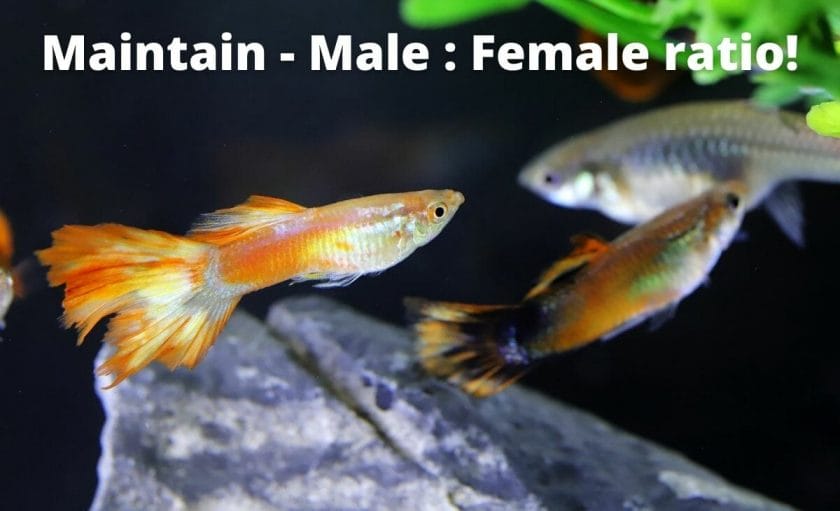
Guppies are very social fish. They are schooling fish i.e. they like to be in groups.
That’s why in your fish tank you should never keep only a single guppy.
Besides, when it comes to keeping guppy fish in a group, the most important thing is to maintain a 2:1 (Female-male) ratio.
So if you want to keep 6 guppies then two of them should be males and four should be females.
This is important because guppies breed a lot. The male guppies continuously chase female guppies which makes the female guppies stressed and tired.
Prolonged stress can cause diseases in female guppies.
That’s why it is very important to have more female guppies than male guppies in a guppy fish tank so the males can not target only a single female guppy.
Besides, as guppies are voracious breeders, don’t get surprised if you end up with a lot of fry in your guppy fish tank in a very short time.
But what to do if you don’t want guppy fry?
Can you keep only males or female guppies in a guppy fish tank?
You can keep only males or females in a guppy fish tank.
Generally, people keep only male guppies in a fish tank because they’re more colorful and vibrant than females.
The only problem with keeping only male guppies in a fish tank is aggression among the males.
They are a few ways to solve this problem. I have written a detailed article that shows you how to keep a male-only guppy tank. You can read the article here.
Guppy fact: Guppy parents eat their fry!
As guppies eat their fry so not all the fry are going to survive.
Along with guppies, you can also keep some other fish that will eat guppy fry to control the guppy population.
4. Maintain good water quality
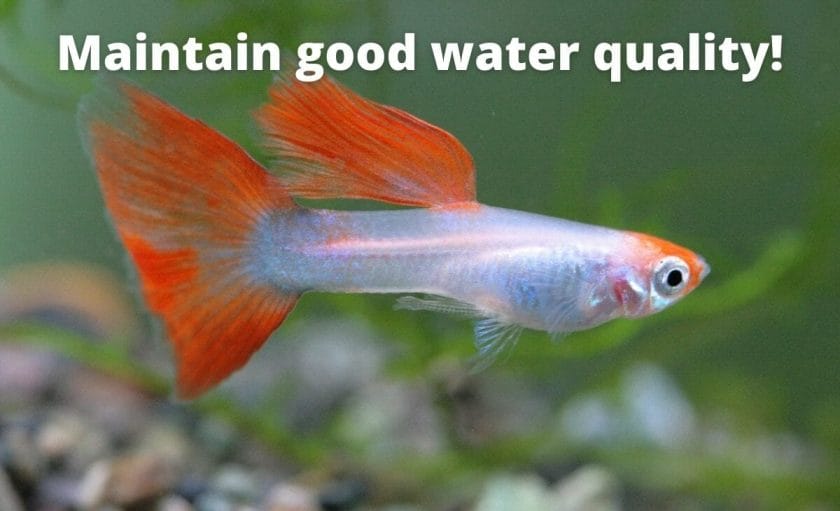
Maintaining good water quality is paramount when it comes to keeping healthy guppy fish and to increase the lifespan of the fish in your tank.
There are several water parameters that you’ll need to keep under the ideal range when it comes to maintaining good water quality in your guppy fish tank.
Let’s start with the most important one:
1. Get rid of ammonia
Your guppy fish tank should not contain any ammonia.
Warning: Even a slight level of ammonia can be deadly to your fish!
You should regularly test your aquarium water for ammonia.
You can easily test your aquarium water using an aquarium water test kit.
I recommend API FRESHWATER MASTER TEST KIT.
It is a liquid-based test kit it is pretty accurate.
You can check its reviews and price at Amazon here.
If you noticed any ammonia levels in your fish tank then you should immediately do a large partial water change to dilute the ammonia levels in your fish tank.
Besides, live aquarium plants also absorb ammonia from your aquarium water and help to keep ammonia in control.
I’ve written a detailed article covering the best aquarium plants to reduce ammonia in your fish tank.
Besides, here are some other ways to lower ammonia levels in your fish tank and get rid of it.
2. Reduce nitrates level in your fish tank
If your fish tank is properly cycled then you may not notice any ammonia levels in your fish tank. But you will notice nitrates levels in your fish tank.
Now, nitrates are far less harmful to your guppies than ammonia.
But still, high nitrates level are harmful to the fish.
How much nitrate is too much?
Generally, the maximum nitrate levels your fish tank should have is 40 PPM.
Anything less than that and your fish will be fine.
If you want to be on the safest side, you should and I encourage you to keep nitrates level below 20 PPM.
How can I reduce the nitrate level in my fish tank?
Doing weekly partial water change dilutes the nitrates level in your fish tank. So you should regularly do the weekly water changes.
Besides, there are some other ways to reduce nitrates in your fish tank.
For example, keeping some live aquarium plants can help to reduce nitrate levels in your fish tank.
Nitrate is food or fertilizer for live aquarium plants.
So if you keep some live plants in your tank then they will consume the nitrates in your fish tank which will help keep the nitrates level low in your fish tank.
3. Keep the temperature between 72° F to 78° F (22° C to 25° C)

Guppies are tropical fish so they need warmer water.
The ideal temperature range for guppies is between 72° F to 78° F (22° C to 25° C).
So in your guppy fish tank, you should keep the temperature within this range.
You can easily maintain the temperature within the ideal range using an aquarium heater
I recommend Cobalt Aquatics Flat Neo-Therm Heater with Adjustable Thermostat.
It has a built-in thermostat. So you can easily maintain the temperature in your guppy tank within the ideal range using this aquarium heater.
You can check its reviews and latest price at Amazon here.
What happens if you don’t maintain the temperature within the ideal range in your guppy fish tank?
Thankfully, guppies can tolerate a wide range of water temperatures!
So, if the temperature in your fish tank is not within the ideal range, say, it is lower than 72° F or more than 78° F then your guppies will not die.
But if the temperature in your fish tank is lower than 72° F for a long time then your guppies will not grow as fast as they should be. And probably they will not reach adulthood ever.
On the other hand, if the temperature in your fish tank is more than 78° F then your guppies will grow too fast. And reach adulthood faster and may die sooner.
Guppy fact: Guppies typically live for about 2 years. Though, several factors can affect the lifespan of guppies.
(Source)
4. Maintain the pH of the water of your guppy fish tank between 7 to 7.2
As mentioned earlier, guppies can tolerate a wide range of water parameters.
But the ideal pH range for guppies is between 7 to 7.2.
Though they can tolerate pH from 5.5 to 8.5.
You can easily check the pH of your aquarium water using an aquarium test kit (link to Amazon).
How to increase pH in your aquarium water?
There are several ways to increase pH in your aquarium water.
The most common way is to use baking soda.
You can add about a tablespoon of baking soda for 5 gallons of your aquarium water to increase its PH.
Besides, you can also add crushed coral or limestone to your fish tank to increase the pH.
How to decrease the pH of your aquarium water?
If the pH of your guppy fish tank water is more than 7.2 PPM then you can add peat moss or natural driftwood in your fish tank to lower the pH.
5. Make sure your aquarium water always has sufficient dissolved oxygen
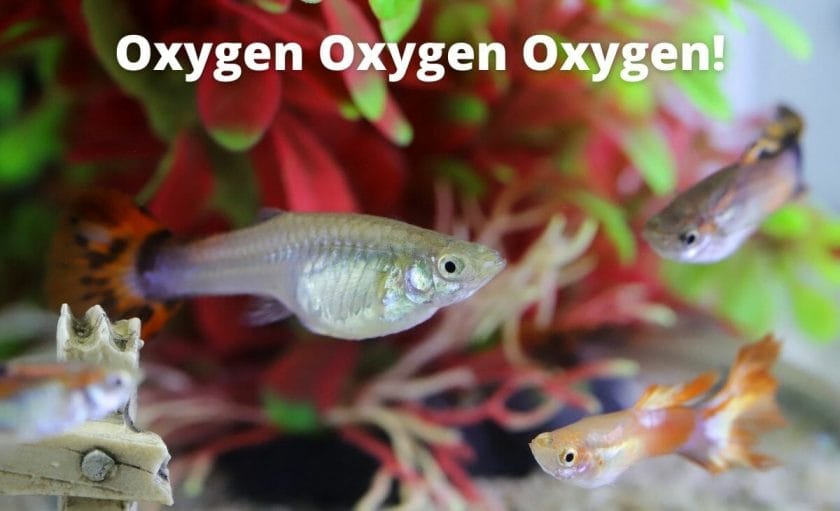
The guppies in your aquarium need dissolved oxygen to survive.
That’s why your fish tank must contain sufficient dissolved oxygen all the time!
The best way to make sure that your aquarium contains sufficient oxygen levels is by introducing an air pump in your fish tank.
An air pump creates water agitation on the aquarium water surface, which helps to oxygenate the fish tank.
I recommend Tetra whisper air pump. It is a quite reliable air pump.
You can check its reviews and price at Amazon here.
Besides, you can also add some oxygenating plants in your fish tank to maintain optimum oxygen levels in your tank.
I have written a detailed article containing the best oxygenating plants for your aquarium. You can read the article here.
Besides, there are other several ways to increase oxygen in your fish tank. I have written about all of them in this article.
6. Create some hiding places in your guppy fish tank
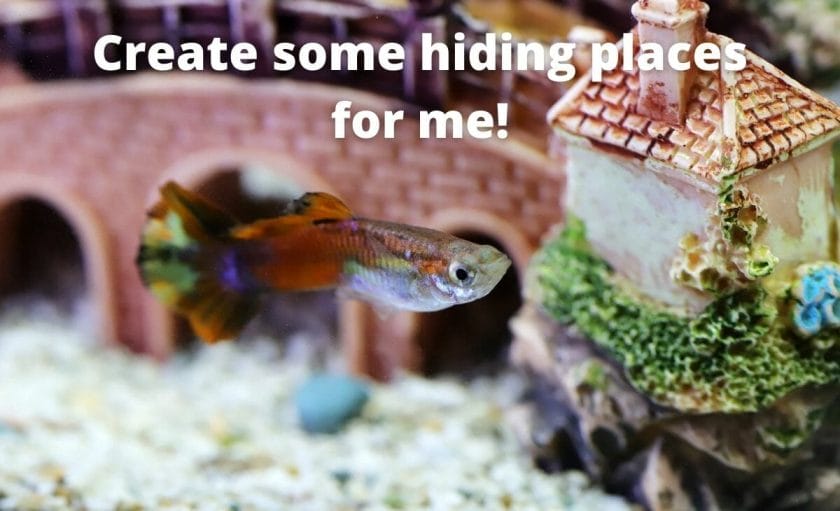
Guppies constantly chase each other!
Especially, if you are keeping both male and female guppies together then male puppies chase female guppies constantly.
This can stress out fish which can lead to diseases and decrease the lifespan of the fish.
That’s why it is very important to create some hiding places in your guppy fish tank so that the fish can hide and rest.
Besides, as guppies eat their fry, if you are planning to breed guppies then guppy fry can hide in the hiding places and survive.
How to create hiding places in your guppy fish tank?
You can easily create some hiding places in your guppy fish tank by introducing some live aquarium plants to your tank.
Live aquarium plants will provide hiding places for your guppies.
Besides, there are a lot of benefits of keeping some live aquarium plants in your tank.
If you are planning to breed guppies then live aquarium plants provide excellent hiding places to the fry in your aquarium.
7. Maintain day and night cycle in your aquarium
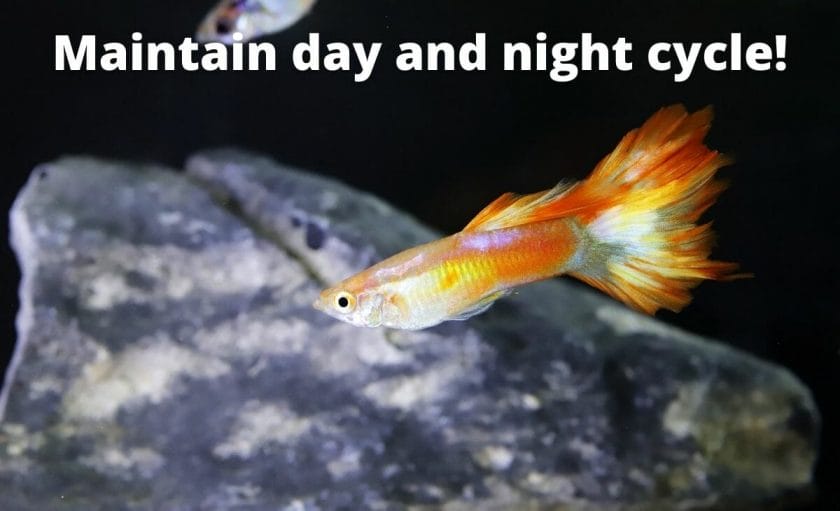
To keep your guppies happy and healthy, you should try to emulate their natural environment.
In the natural environment of guppies, they have a consistent day and night cycle.
So you should emulate the same in your guppy fish tank.
To maintain a consistent day and night cycle in your guppy fish tank you should install an aquarium light in your guppy fish tank.
And keep the aquarium light off for at least 8 hours during the night.
Keeping the aquarium light on for the remaining 16 hours will emulate the day in your fish tank.
Keeping the aquarium lights on for 16 hours is especially important if your fish tank is not in a well-lit area in your house.
Besides, aquarium lights also enhance the coloration of guppies. So they look beautiful under aquarium light.
Also, you should keep the aquarium lights off for 8 hours every day to emulate the night in your fish tank.
If you don’t already have an aquarium light installed in your aquarium then you should get one.
I recommend Finnex Stingray 2 Aquarium LED Light (link to Amazon).
It is from a reputed brand and it is a good beginner aquarium light.
This aquarium light is also suitable for live aquarium plants.
So if you have some live plants or if you want to keep some live aquarium plants in your tank then this light will help them to grow better.
You can check its reviews and the latest price at Amazon here
You can also get a timer to keep consistency with the aquarium light.
I recommend Nearpow digital timer (link to Amazon).
It is a fully programable timer.
You can check its reviews and the latest price at Amazon here
8. Keep some live aquarium plants in your guppy fish tank
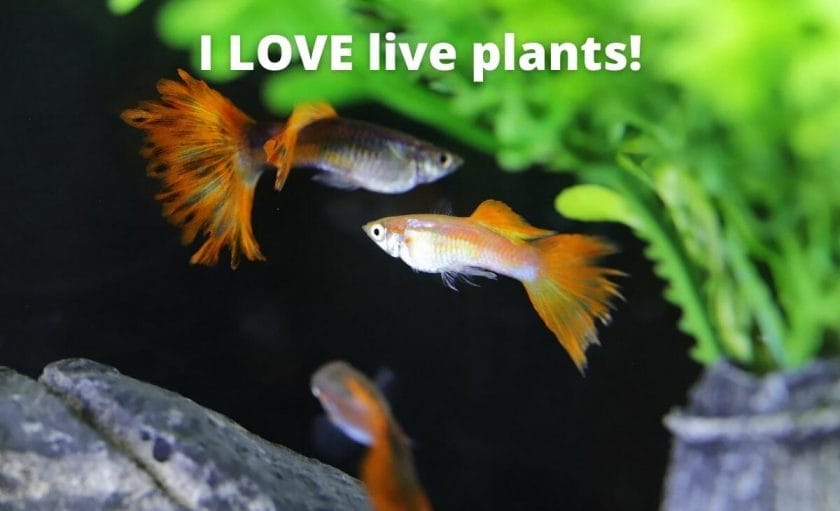
The natural habitat of guppies contains live aquarium plants. So adding some live aquarium plants in your tank can help to emulate the natural habitat of guppies so the guppies will feel at home.
Besides, there are a lot of benefits of keeping live aquarium plants in a fish tank.
- Live aquarium plants release oxygen in the fish tank during the day which helps to keep your fish tank well oxygenated.
- Live aquarium plants absorb nutrients that algae need to grow which helps to reduce algae in your fish tank.
- If you plant some root feeder aquarium plants in your tank then the roots of the plant will grow throughout the substrate of your fish tank which helps to avoid forming poisonous air pockets in your tank.
- Live aquarium plants help to keep your aquarium water clean by absorbing ammonia. nitrite, and nitrate.
These are just a few benefits of keeping live aquarium plants in your fish tank.
You can learn about all the benefits of keeping live aquarium plants here.
I’ve written a detailed article covering the best aquarium plants for guppies.
9. Observe the behavior of your guppy fish
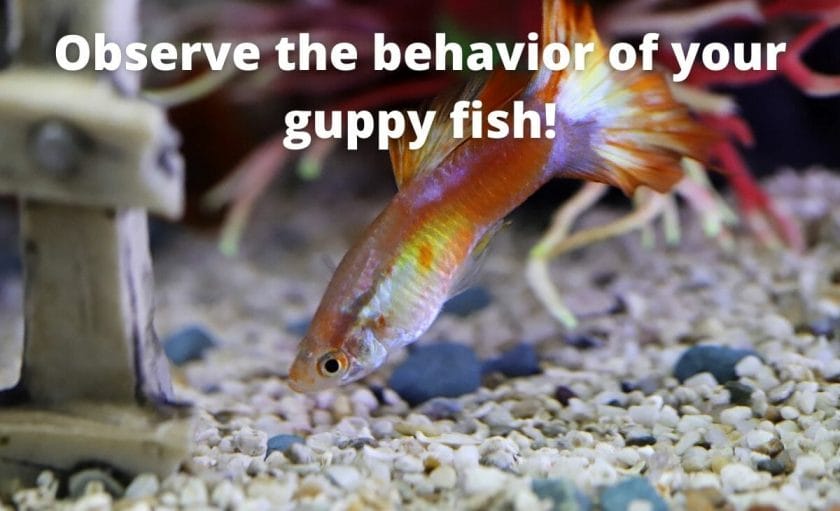
That’s why it is very important to regularly observe the behavior of your fish.
Generally, feeding time is the best time to observe your guppy fish.
Because this is the time when generally all the puppies are very excited and active. So it is very easy to spot a sick fish.
Common guppy fish diseases, symptoms, and treatment
Now I am going to tell you a few common guppy fish diseases to look out for in your guppies.
1. Ich
Ich is is the most common disease in not only guppies but any freshwater fish.
When your guppies are suffering from Ich, you’ll notice white spots on their bodies.
Besides, when guppies are suffering from Ich they also lose appetite.
So it is very easy to spot Ich when you are feeding your guppies. And if you treat Ich early on them it is not a deadly disease.
As far as treatment of Ich is concerned, you can use aquarium salt or Seachem Paraguard (link to Amazon) to treat Ich.
2. Fin rot
Fin rot is another common disease found in freshwater fish.
It is caused due to bacterial or fungal infection.
You can easily spot fin rot if the fins of the fish looked like they are stuck together.
Fin rot is generally caused by poor water quality i.e. high ammonia in the aquarium water.
It can also be caused due to fin nipping.
To treat a fish suffering from fin rot, first, you will need to separate the fish and put it into a hospital tank.
Then you can treat the fin rot using antibiotics such as Seachem Paraguard (link to Amazon)
3. Guppy disease
Yes, there is a disease called Guppy disease.
It is called so because it mostly occurs in guppies.
This disease is caused due to low water temperature and poor water quality in the aquarium.
Spotting the Guppy disease can be tricky because when the fish is suffering from guppy disease you will notice white spots on its body just like Ich.
So sometimes you may think that your fish is suffering from Ich but it is actually suffering from Guppy disease.
The only way to identify Guppy disease is by microscopic analysis.
Depending on the stage of the disease the treatment can vary.
At an early stage, you can treat the fish with formalin or malachite green.
At later stages, you will need to treat your guppies with Seachem Cupramine (link to Amazon).
As this disease is very tricky to identify and treat.
It is best to avoid this disease.
And the best way to avoid this disease is by maintaining good water quality i.e. maintaining the ideal water parameters, especially the temperature.
And always make sure that that your fish tank doesn’t contain ammonia.
10. Start with high-quality guppies

Now, this tip may not be applicable to everybody if you already have guppies in your tank.
But if you are just starting out with your guppy fish tank and you don’t already have guppies in your tank then you should make sure to get your guppies from a reputed source.
This way you will start out with healthy guppies.
And down the road, it will be very easy for you to keep you are guppies healthy.
You can ask fellow fish keepers about where to get your guppies from to make sure that you are getting them from a good source.
11. Quarantine your new guppies
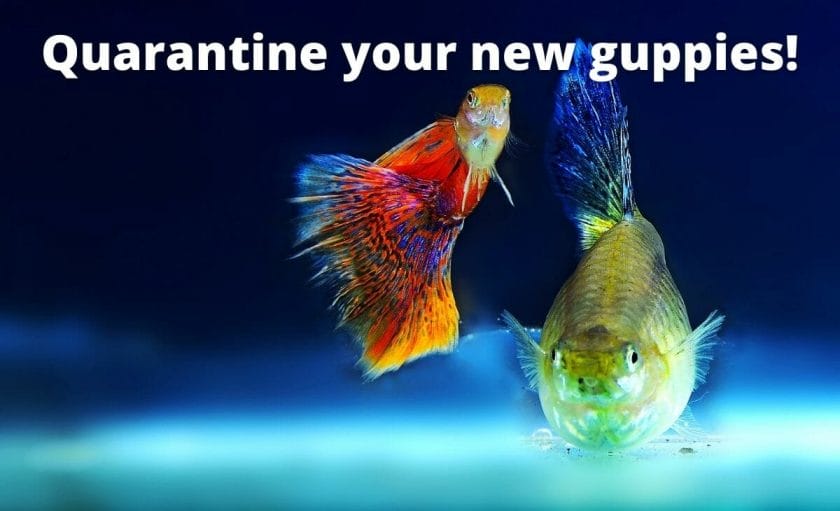
It is very important to quarantine any new fish before putting it in your main display tank.
Because, if you don’t, then if the new fish is infected then it will spread the disease among all the fish in your main display tank!
How to set up a current time tank?
To set up a quarantine tank you can use another fish tank or you can use a plastic tub. Any one of them can work.
But choosing a fish tank is generally a good idea because then you can easily see any symptoms of diseases on the fish.
Now you will need to cycle the quarantine fish tank before introducing fish into it.
Here are the fastest ways to cycle your quarantine tank.
Once your quarantine tank is cycled then you will need to add essential equipment like an aquarium filter and an aquarium heater to your quarantine tank.
Generally, keeping the quarantine tank bare-bottom is a good idea because then it is very easy to clean.
Also, you should avoid keeping any live aquarium plants in your quarantine tank.
Keep it as simple as possible just put the essential things in your quarantine tank!
Once your quarantine tank is cycled and set up then you can introduce new guppies into the quarantine tank.
Now you will need to add some medications into the quarantine tank to treat the fish if it is infected.
Yes, you will need to add the medications into the tank even before noticing any symptoms of any diseases in your fish!
What medications should I add to the Quarantine tank?
Basically, you will need to add the medications that treat the common diseases in freshwater fish.
- You should add ich-x (link to Amazon) to treat common diseases like ich, velvet, etc
- You should add Marsel maracun (link to Amazon) to treat fun rot
- Fritz parashield (link to Amazon) to treat other parasites
You should follow the instructions mentioned on the bottles of the medication.
How long should I keep my new fish in a quarantine tank?
Generally, you should keep new fish for 2 to 4 weeks in your quarantine tank.
When your fish are in the quarantine tank, you should regularly observe their behavior and lookout for signs of any disease.
Once the quarantine period is over then you can add your new fish to your main display tank.
Conclusion
So these are the tips to keep your guppies happy and healthy in your aquarium.
Overall, to keep your guppies happy and healthy, you will need to maintain good water quality in your aquarium, feed your guppies high-quality food, and try to emulate their natural habitat as much as possible.
I hope you found this it’s helpful.
If you do, please share it with a guppy tank owner.
Happy fishkeeping!